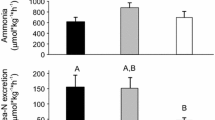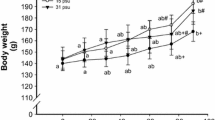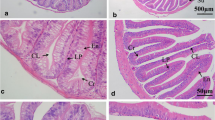Summary
-
1
The emu (Dromaius novaehollandiae) is well adapted to the Australian semi-desert, although it has a limited renal concentrating ability. One problem is the balance between the ability to resorb ions and water from ureteral urine during its reflux into the coprodeum and rectum (colon), and the rate of ureteral inflow. To elucidate this problem the osmotic and nutritional state of wild birds needs to be studied in order to integrate laboratory and field investigations.
-
2.
This paper reports plasma values and the composition of gut contents from birds shot in the arid interior during the hot, dry summer. The wild birds showed little sign of osmotic stress with only marginally elevated plasma osmolality, and near-isotonic contents of the coprodeal/rectal segment (332±6 mOsm). Intestinal contents showed that the birds were feeding on berries of bushes with either a high (Rhagodia) or a low (Santalum) content of NaCl. The coprodeal/rectal concentration of Na+ and Cl- were high enough to permit solute-linked water flow. There was little sign of fermentation.
-
3.
In vitro investigation in the Ussing chamber of isolated coprodeum and rectum epithelium revealed an inwardly directed current which was amiloride inhibitable and amino acid independent, suggesting electrogenic Na absorption of around 4 μmol·h-1·cm-2 mucosal area regardless of the NaCl intake.
-
4.
Based on previously determined transport parameters of the coprodeum/rectum epithelium (Dawson et al. 1985) and ureteral excretion rates of water and electrolytes (Dawson et al. 1991), it is concluded that the lower gut can resorb the major part of the water coming from the kidneys (and ileum) on both low and high NaCl intakes. The lower gut is most important in the xeric adaptation. The reason for the apparently high transport capacity, larger than in other birds, of the lower gut (serosal area) was a high degree of folding of the mucosal surface (increasing surface area by factor of five).
Similar content being viewed by others
Abbreviations
- PD :
-
potential difference
- SCFA :
-
short chain fatty acids
- SCC :
-
short-circuit current
- R :
-
resistance
References
Choshniak I, Munck BG, Skadhauge E (1977) Sodium chloride transport across the chicken coprodeum. Basic characteristics and dependence on sodium chloride intake. J Physiol Lond 271:489–504
Clauss W, Dantzer V, Skadhauge E (1988) A low-salt diet facilitates Cl secretion in hen lower intestine. J Membrane Biol 102:83–96
Davies SJJF (1968) Aspects of a study of emus in semi-arid Western Australia. Proceedings of the Ecological Society of Australia 3:160–166
Dawson TJ, Herd RM (1983) Digestion in the emu: Low energy and nitrogen requirements of this large ratite bird. Comp Biochem Physiol 75A:41–45
Dawson TJ, Herd RM, Skadhauge E (1983) Water turnover and body water distribution during dehydration in a large arid-zone bird, the emu, Dromaius novaehollandiae. J Comp Physiol B 153:235–240
Dawson TJ, Read D, Russell EM, Herd RM (1984) Seasonal variation in daily activity patterns, water relations and diet of emus. The Emu 84:93–102
Dawson TJ, Herd RM, Skadhauge E (1985) Osmotic and ionic regulation during dehydration in a large bird, the emu (Dromaius novaehollandiae): An important role for the cloaca-rectum. Q J Exp Physiol 70:423–436
Dawson TJ, Maloney SK, Skadhauge E (1991) The role of the kidney in electrolyte and nitrogen excretion in a large flightless bird, the emu, during different osmotic regimes, including dehydration and nesting. J Comp Physiol B 161:165–171
Herd RM, Dawson TJ (1984) Fiber digestion in the emu, Dromaius novaehollandiae, a large bird with a simple gut and high rates of passage. Physiol Zool 57:70–84
Lind J, Munck BG, Olsen O, Skadhauge E (1980) Effects of sugars, amino acids and inhibitors on electrolyte transport across hen colon at different sodium chloride intakes. J Physiol (Lond) 305:315–325
Luciano L, Reale E, Rechkemmer G, von Engelhardt W (1984) Structure of zonulae occludentes and the permeability of the epithelium to short-chain fatty acids in the proximal and the distal colon of guinea pig. J Membrane Biol 82:145–156
Skadhauge E (1968) The cloacal storage of urine in the rooster. Comp Biochem Physiol 24:7–18
Skadhauge E (1974) Renal concentrating ability in selected West Australian birds. J Exp Biol 61:269–276
Skadhauge E (1977) Solute composition of the osmotic space of ureteral urine in dehydrated chickens (Gallus domesticus). Comp Biochem Physiol 56A:271–274
Skadhauge E (1981) Osmoregulation in birds. Zoophysiology, vol. 12. Springer, Berlin Heidelberg, New York
Skadhauge E (1989) An overview of the interaction of kidney, cloaca, lower intestime, and salt gland in avian osmoregulation. In: Progress in Avian Osmoregulation. Hughes MR, Chadwick A (eds). Leeds Philosophical and Literary Soc Leeds, UK, pp 333–346
Skadhauge E, Kristensen K (1972) An analogue computer simulation of cloacal resorption of salt and water from ureteral urine in birds. J Theor Biol 35:473–487
Skadhauge E, Bradshaw SD (1974) Saline drinking and cloacal excretion of salt and water in the zebra finch. Am J Physiol 227:1263–1267
Skadhauge E. Dawson TJ (1980) In vitro studies of sodium transport across the lower intestine of a desert parrot. Am J Physiol 239:R285-R290
Skadhauge E, Thomas DH, Chadwick A, Jallageas M (1983) Timecourse of adaptation to low and high NaCl diets in the domestic fowl. Effects on electrolyte excretion and on plasma hormone levels (aldosterone, corticosterone and prolactin). Pflügers Arch 396:301–307
Skadhauge E, Warüi CN, Kamau JMZ, Maloiy GMO (1984a) Function of the lower intestine and osmoregulation in the ostrich: Preliminary anatomical and physiological observations. Q J Exp Physiol 69:809–818
Skadhauge E, Munck BG, Rice GE (1984b) Regulation on NaCl and water absorption in duck intestine. In: Lecture notes on coastal and estuarine studies. Pequeux A, Gilles R, Bolis L (eds) Springer, Berlin, Heidelberg, New York, 131–142
Thomas DH, Skadhauge E, Read MW (1979) Acute effects of aldosterone on water and electrolyte transport in the colon and coprodeum of the domestic fowl (Gallus domesticus) in vivo. J Endocr 83:229–237
Thomas DH, Skadhauge E (1982) Time-course of adaptation to low and high NaCl diets in the domestic fowl. Pflügers Arch 395:165–170
Thomas DH, Skadhauge E (1980) Function and regulation of the avian caecal bulb: influence of dietary NaCl and aldosterone on water and electrolyte fluxes in the hen (Gallus domesticus) perfused in vivo. J Comp Physiol B 159:51–60
Author information
Authors and Affiliations
Rights and permissions
About this article
Cite this article
Skadhauge, E., Maloney, S.K. & dawson, T.J. Osmotic adaptation of the emu (Dromaius novaehollandiae). J Comp Physiol B 161, 173–178 (1991). https://doi.org/10.1007/BF00262881
Accepted:
Issue Date:
DOI: https://doi.org/10.1007/BF00262881




